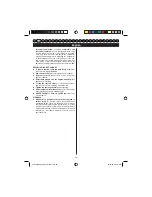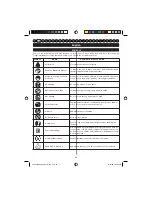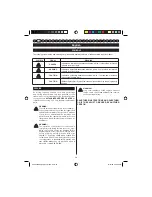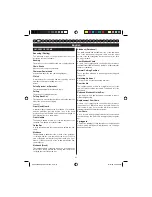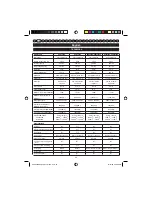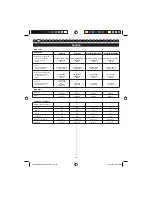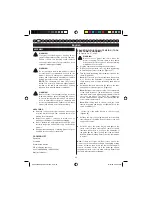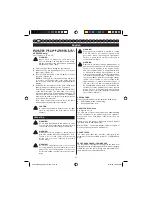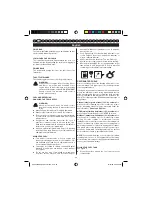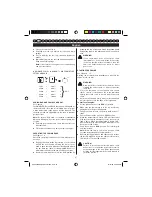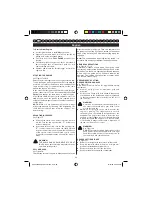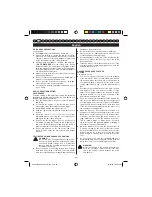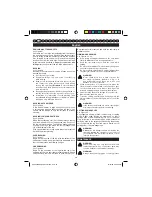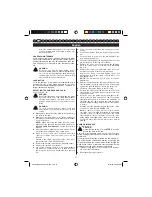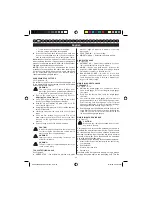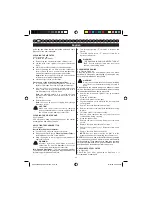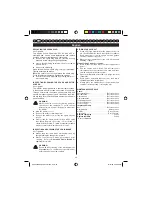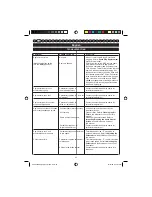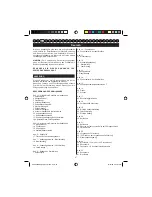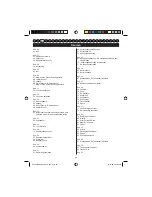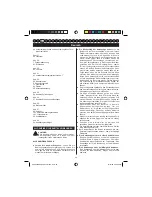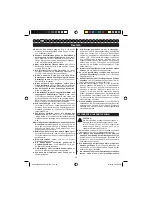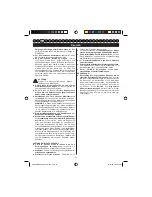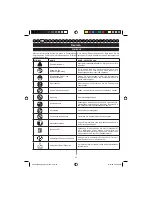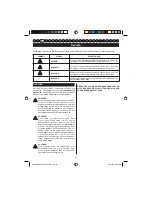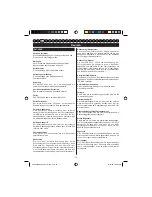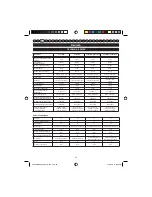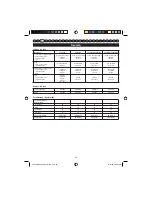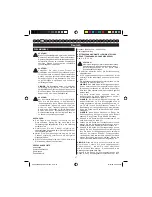
42
English
GB
F
D
E
I
P
NL
S
DK
N
FIN GR
HU
CZ
RU
RO
PL SLO HR
TR EST
LT
LV
SK
BG
o Too low increases the potential for kickback.
o Not low enough decreases cutting ability.
■
If the cutter teeth hit hard objects such as nails and
stones, or are abraded by mud or sand on the wood,
have an authorised service centre sharpen the chain.
Note:
Inspect the drive sprocket for wear or damage
when replacing the chain. If signs of wear or damage are
present in the areas indicated, have the drive sprocket
replaced by an authorised service centre.
NOTE:
If you do not fully understand the correct
procedure for sharpening the chain after reading the
instructions that follow, have the saw chain sharpened
by an authorised service centre or replace with a
recommended low-kickback chain.
SHARPENING THE CUTTERS
See Figures 48 - 51.
Be careful to file all cutters to the specified angles and
to the same length, as fast cutting can only be obtained
when all cutters are uniform.
WARNING:
The saw chain is very sharp. Always wear
protective gloves when performing maintenance
to the chain to prevent serious personal injury.
■
Tension the chain prior to sharpening. Refer to
Adjusting The Chain Tension
.
■
Use a 5/32 in. (4 mm) diameter round file and holder.
Do all of your filing at the midpoint of the bar.
■
Keep the file level with the top plate of the tooth. Do
not let the file dip or rock.
■
Using light but firm pressure. Stroke towards
the front
corner of the tooth.
■
Lift the file away from the chain tooth on each return
stroke.
■
Put a few firm strokes on every tooth. File all left
hand cutters in one direction. Then move to the other
side and file the right hand cutters in the opposite
direction.
■
Remove filings from the file with a wire brush.
CAUTION:
A dull or improperly sharpened chain can cause
excessive engine speed during cutting, which
may result in severe engine damage.
WARNING:
Improper chain shar pening increases the
potential of kickback.
WARNING:
Failure to replace or repair a damaged chain can
cause serious injury.
TOP PLATE FILING ANGLE
See Figure 52.
■
CORRECT 30° – file holders are marked with guide
marks to align file properly to produce correct top
plate angle.
■
LESS THAN 30° – for cross cutting.
■
MORE THAN 30° – feathered edge dulls quickly.
SIDE PLATE ANGLE
See Figure 53.
■
CORRECT 80° – Produced automatically if you use
the correct diameter file in the file holder.
■
HOOK – “Grabs” and dulls quickly; increases the
potential of KICKBACK. Results from using a file with
a diameter too small or a file held too low.
■
BACKWARD SLOPE – Needs too much feed
pressure; causes excessive wear to the bar and
chain. Results from using a file with a diameter too
large or file held too high.
MAINTAINING DEPTH GAUGE
CLEARANCE
See Figure 54 - 56.
■
Maintain the depth gauge at a clearance of .025 in.
Use a depth gauge tool for checking the depth gauge
clearances.
■
Every time the chain is filed, check the depth gauge
clearance.
■
Use a flat file and a depth gauge jointer to lower all
gauges uniformly. Use a .025 in. depth gauge jointer.
After lowering each depth gauge, restore original
shape by rounding the front. Be careful not to damage
adjoining drive links with the edge of the file.
■
Depth gauges must be adjusted with the flat file in the
same direction the adjoining cutter was filed with the
round file. Use care not to contact cutter face with flat
file when adjusting depth gauges.
MAINTAINING THE GUIDE BAR
See Figure 57.
CAUTION:
Make sure the chain has stopped before you do
any work on the saw.
Every week of use, turn over the guide bar on the saw to
distribute the wear for maximum bar life. The bar should
be cleaned every day of use and checked for wear and
damage. Feathering or burring of the bar rails is a normal
process of bar wear. Such faults should be smoothed
with a file as soon as they occur.
A bar with any of the following faults should be replaced:
■
Wear inside the bar rails that permits the chain to lay
over sideways
■
Bent guide bar
■
Cracked or broken rails
■
Spread
rails
Lubricate guide bar sprockets weekly. Using a grease
syringe, lubricate weekly in the lubricating hole. Turn the
HCS3435A-25lgs manual.indd Sec1:42
HCS3435A-25lgs manual.indd Sec1:42
12/19/08 3:08:57 PM
12/19/08 3:08:57 PM

